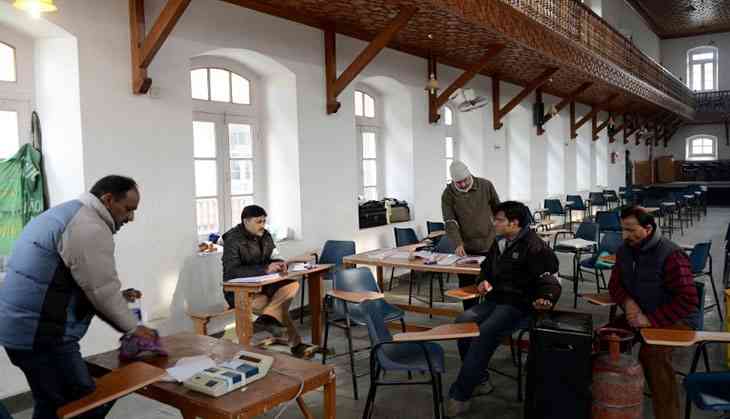Kashmir turmoil: Why Election Commission can't escape blame for present crisis

In 1987, a failed election led to the outbreak of armed militancy in Kashmir. Three decades later, another failed election is set to plunge Kashmir into yet another round of turmoil.
The bypoll to the Srinagar Lok Sabha constituency, may not have been rigged like the 1987 Assembly elections are said to have been. But it was the most violent election Kashmir has witnessed in at least two decades, with 8 people being killed and several others injured. The turnout of 7% was also abysmally low and reflected the incredulity of Kashmiri civilians towards the democratic process.
This failure of the electoral process was epitomised by the manner in which the Indian Army used Farooq Ahmed Dar, a Kashmiri civilian, as a human shield. That too just a little after he had cast his vote in the elections.
While the state and the central government have been facing flak for the complete political breakdown in Kashmir, one institution that seems to have escaped the blame is the Election Commission of India (ECI).
A question that needs to be asked is – did the ECI make a mistake in trying to hold the by-elections in April?
According to reports, the Union Home Ministry has said that it had actually warned the ECI against holding the elections. Apparently, Union Home Secretary Rajiv Mehrishi had written to the ECI advising that the elections be postponed as the “atmosphere was not conducive” for any democratic process.
The ECI overruled the Home Ministry. But given the violence and the poor turnout, the Home Ministry might have been right. And after the violence, the ECI did end up postponing the Anantnag bypoll to end May. But by that time that damage had already been done.
What came across on polling day was that the polling officials and paramilitary personnel were completely unprepared for handling the protests and stone-pelting near the polling stations. There also appears to have been an intelligence failure at the local level.
The situation was such that in some areas, civilians had to accompany poll officials and paramiltary personnel till they reached a safe area. There is said to have been an additional deployment of 30,000 troops but they clearly did not know how to handle protestors and stone-pelters and ended up firing and killing civilians in the process. This has further fuelled the resentment in the Valley and another round of protests is likely to begin.
Political disconnect
The ECI's decision to go ahead with the elections reflects the broader disconnect between New Delhi and the ground realities in Kashmir. The killing of Hizbul Mujahideen commander Burhan Wani in July last year was followed by a phase of intense protests and shutdowns. Over a hundred Kashmiri civilians were killed in firing by security forces and scores were blinded by pellets. Given this reality, it was only to be expected that protests would resume once the winter dissipates.
In such a scenario, it was naïve to expect that the civilian response to the by-elections would be anything but defiant.
The 2014 Lok Sabha elections in Srinagar were hailed as a triumph of democracy in pro-India circles. 3.12 lakh voters exercised their franchise. Farooq Abdullah, the mighty former chief minister and National Conference president, suffered a defeat at the hands of the PDP's Tariq Hamid Karra.
If that was the triumph of democracy, this was the reverse. It was a poll necessitated by Karra's resignation from PDP in protest against the PDP-BJP government's handling of the 2016 protests and the killings that took place. Despite Abdullah contesting, the turnout was just about one fourth of what it was in 2014. It is said to have been the most violent election held in Kashmir since the outbreak of militancy. And to top it all, the most defining image wasn't that of voters making a beeline towards polling booths or of the victorious party celebrating, but of a voter being used as a human shield by the army.
It is pertinent to mention that ahead of bypolls, the PDP's Anantnag candidate Tasaduq Mufti and the party's youth wing had invited stone-pelters from Pulwama district for talks. But the initiative is said to have been dismissed harshly by the BJP. Without the backing of the Centre and PDP's alliance partner, Mufti's initiative proved a non-starter.
Perhaps the wave in Uttar Pradesh made the BJP feel that it can take a tough stand in Kashmir and get away with it. After all, keeping the Kashmir issue simmering does help the party polarise votes in rest of the country. And the ECI seems to have played along, instead of comprehending the ground realities in Kashmir.
In his work Explaining the Kashmir Insurgency, Sumit Ganguly has recognised the “failure in institution building” as one of the primary reasons behind the Kashmir conflict. The ineptitude of the ECI in this case is only symptomatic of the failure of institutions in Kashmir.
It is precisely this failure of institutions that was reflected in tying up of a Kashmiri civilian as a human shield, in complete violation of international norms, constitutional values and even the Indian Army's own code of conduct. It was a naked parade of militarised masculinity but the state institutions turned a blind eye to it.
Now a cycle of violence has been unleashed, which is evident from the recent killing of former Ikhwani Rashid Billa and public prosecutor Imtiyaz Ahmad Khan. There are also attempts to clampdown on the voices of the main Opposition party, whose political discourse is being seen by the establishment as too independent. The turmoil created by this mistimed by-poll is unlikely to end any time soon. And with the ECI scheduling the Anantnag bypoll for end May, Kashmir may be in for another violent summer.
Perhaps, ECI should heed the advice it recently gave to a political party, and introspect.
First published: 20 April 2017, 18:54 IST
